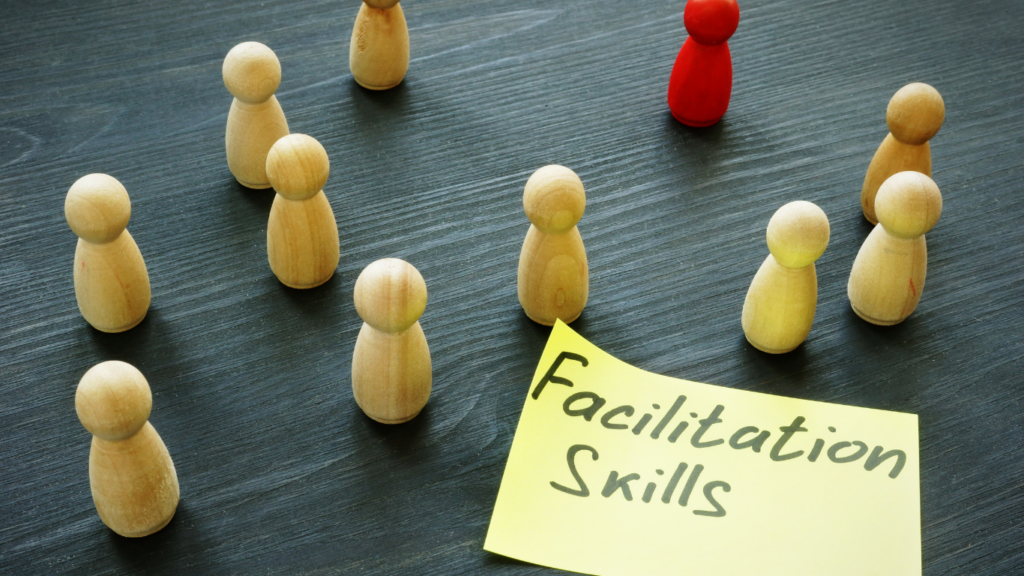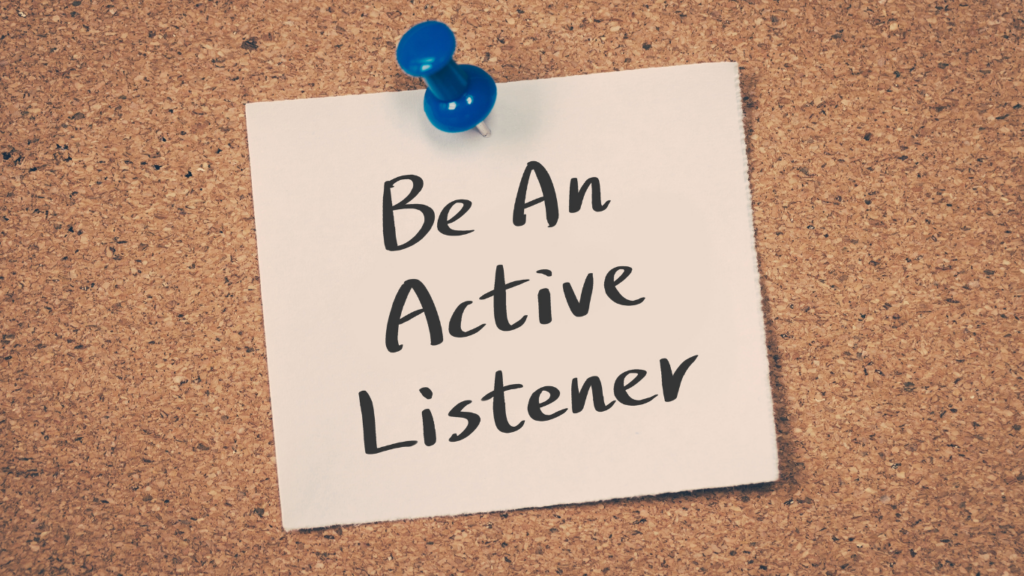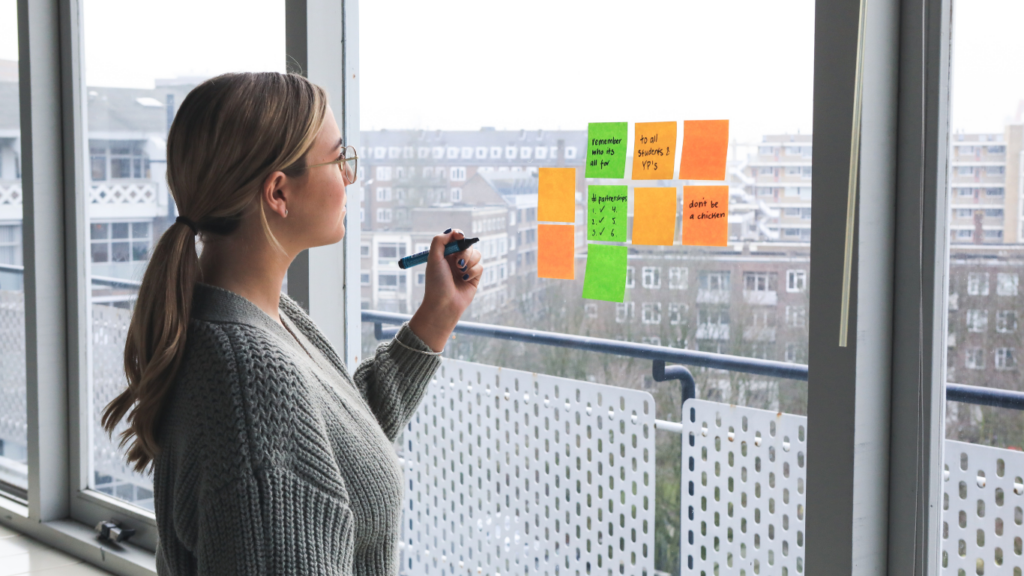Effective team facilitation skills are essential for driving collaboration, productivity, and innovation within organizations. Mastering facilitation skills, particularly in today’s dynamic and interconnected business landscape, is crucial. The ability to guide groups toward common goals, foster an inclusive and supportive environment, and implement team leader facilitation strategies sets a strong foundation. A team facilitator possesses a unique set of competencies that enable them to orchestrate successful meetings, navigate conflicts, and encourage participation—all while harnessing the collective intelligence of diverse team members. Basic facilitation skills, often underrated, form the backbone of these competencies, making facilitating an indispensable skill in your leadership toolbox!
This article delves deep into the nuances of team facilitation, emphasizing the importance of these basic and advanced skills, and provides actionable insights to bolster the facilitation prowess and attributes of a competent group facilitator. Whether you’re a seasoned facilitator looking to refine your approach or an aspiring one aiming to lay a strong foundation, understanding and sharpening group facilitation techniques will empower you to lead teams to greater heights.
As we reveal 7 essential facilitation tips and tricks, remember this truth: a dedicated facilitator can steer the team through any communication challenge, be it in low-stakes or high-stakes scenarios, as long as there’s a willingness to work collaboratively.

What is a synonym for facilitation?
Enablement, much like facilitation, encompasses the act of empowering and supporting individuals or groups to achieve their goals. It involves providing the necessary tools, resources, and guidance to enable others to accomplish tasks or overcome challenges.
Just as a facilitator helps to remove obstacles and streamline processes, an enabler creates an environment that encourages growth, development, and success. Through enablement, individuals are equipped with the means to maximize their potential and take ownership of their actions.
It emphasizes empowering others to become self-sufficient, fostering independence and self-confidence. Ultimately, enablement is about empowering individuals or groups to realize their full potential and achieve desired outcomes.
The reasons facilitation skills are needed
Facilitation skills play a critical role in creating a productive discussion and engaging group dynamics. A facilitator possesses active listening skills, enabling them to truly understand and empathize with the perspectives and needs of group members.
By actively listening, facilitators can create an inclusive environment where everyone feels heard and valued, leading to more effective communication and collaboration. Additionally, a skilled facilitator understands the importance of encouraging participation from all group members.
They create space for individuals to contribute their own ideas and insights, fostering a sense of ownership and engagement in group work among the participants. This active participation not only enhances the quality of discussions but also increases the likelihood of reaching a successful outcome.

Remote facilitation skills
Facilitation skills are not limited to in-person interactions. With the rise of remote work and virtual meetings, facilitators must also be proficient in virtual facilitation techniques.
Virtual facilitators should learn to adapt their skills to create an inclusive and interactive environment in virtual settings, leveraging technology tools effectively and encouraging active participation from all participants.

The facilitation process
The facilitation process itself is a core element of effective facilitation skills. A skilled facilitator plans and guides the meeting process, ensuring that it stays focused and on track toward the desired outcomes.
They establish clear objectives, create an agenda, and set ground rules to provide structure and direction for group discussions. Throughout the meeting, the facilitator actively manages the group dynamics, facilitating productive discussions and helping to resolve conflicts or disagreements that may arise.
They also pay attention to body language and non-verbal cues, allowing them to gauge the level of engagement and understanding within the group.

Optimizing team performance with facilitation skills
Team facilitation plays a crucial role in optimizing a team’s performance and achieving desired outcomes. Facilitators with significant facilitation experience are equipped with a repertoire of different techniques to effectively guide and support teams.
Facilitators understand the importance of being directly involved in the facilitation process, actively engaging with team members and fostering an environment of open communication. When as leadership team member, you have good communication skills you are ahead of most managers. These skills are essential for facilitators, as they need to ensure that information flows smoothly and that everyone has a voice.
How do you plan a good facilitation process?
Planning an effective facilitation process requires careful consideration and attention to various crucial elements. A skilled facilitator not only aims to achieve desired outcomes but also focuses on fostering a positive and engaging experience for all participants.
To ensure successful meetings or planning sessions, facilitators should prioritize the following key points during the planning phase.
Steps for facilitation planning
First and foremost, it is essential for the facilitator to meticulously plan each aspect of the process beforehand. This includes defining clear objectives, determining the appropriate structure and format for the session, and identifying the necessary resources and materials. How much preparation effort is needed depends on your experience and the team.
By laying out a well-organized framework, the facilitator sets the stage for a smooth and productive session. Additionally, considering the participants’ needs and expectations is crucial.
A facilitator should take into account the diverse perspectives and ensure that the session caters to the specific requirements and interests of the individuals involved. This involves tailoring the agenda, activities, and discussions to create a meaningful and inclusive environment where everyone feels valued and engaged.
Anticipating potential challenges or conflicts and having contingency plans in place are vital for a successful facilitation process. A skilled facilitator will proactively identify possible obstacles and prepare strategies to address them effectively, such as implementing conflict resolution techniques or adapting the agenda as needed.
Ultimately, through thorough planning and thoughtful consideration of various factors, facilitators can create an environment conducive to collaboration, open dialogue, and successful outcomes.

Facilitating a team meeting or planning session
Facilitating a planning meeting requires careful consideration and preparation as well as business planning success. As a facilitator, it is essential to ask yourself, “What is my best option for this meeting?” This question prompts you to assess the meeting’s objectives, desired outcomes, and the needs of the participants.
By understanding these factors, you can determine the most effective approach for the meeting, whether it involves brainstorming, decision-making, problem-solving, or strategic planning. Your best option may involve creating an agenda that outlines key discussion points, allocating sufficient time for each agenda item, and using appropriate facilitation techniques to encourage active participation and collaboration. By considering the best option for the meeting, you can set the stage for a successful planning session that yields meaningful results and moves the team closer to their goals.
Start the meeting on time
As a facilitator, starting a meeting on time holds significant importance. It sets the tone for the entire session and demonstrates respect for everyone’s time and commitment. When a meeting begins promptly, it sends a message that the facilitator values efficiency and professionalism. It allows participants to feel confident that their time will be well-utilized, increasing their engagement and focus.
Moreover, starting on time shows that the facilitator is organized and prepared, creating a positive impression and establishing credibility. By prioritizing punctuality, a facilitator sets the stage for a productive meeting, fosters a sense of discipline among participants, and maximizes the opportunity to achieve the meeting’s objectives effectively.

Review the agenda, objectives, and ground rules for the meeting
Reviewing the agenda, objectives, and ground rules for a meeting is a critical step in effective facilitation.
As a facilitator, it is important to check-in with the other group members to ensure consensus on the meeting agenda. This allows for transparency and inclusion, as each participant’s input and expectations are considered. By seeking feedback and incorporating it into the agenda, the facilitator ensures that the meeting aligns with the desired outcomes and addresses the specific needs of the group.
In addition to reviewing the agenda, it is essential to establish clear ground rules. Ground rules provide a framework for the meeting, outlining behavioral expectations and promoting a respectful and productive environment. These rules may include guidelines for active listening, respecting others’ perspectives, maintaining confidentiality, and adhering to time limits. Setting out ground rules at the beginning of the meeting helps manage expectations, encourages participation, and minimizes disruptions or conflicts.
By reviewing the agenda, objectives, and establishing ground rules, the facilitator sets the stage for a focused and successful meeting. This process ensures that all participants are aligned and engaged, enabling them to work collaboratively towards the desired outcomes. It demonstrates the facilitator’s commitment to creating a structured and respectful environment that maximizes productivity and fosters effective communication among team members.
How do facilitators ask questions?
How do facilitators ask questions to enhance the problem-solving process and stimulate critical thinking? Facilitators adopt a question-based approach, prioritizing inquiry over providing immediate solutions.
By asking questions, facilitators encourage active engagement and participation from team members, fostering a collaborative and inclusive problem-solving environment. This questioning method serves multiple purposes, such as breaking down complex problems into manageable pieces, gathering diverse input from the team, and evaluating issues from various angles. Sociological questions, in particular, can be valuable tools for facilitators, as they delve into the social dynamics, perspectives, and relationships that impact the problem at hand.
Facilitators strategically employ different types of questions to drive discussions and prompt deeper exploration. Open-ended questions encourage expansive thinking and elicit detailed responses, enabling participants to articulate their thoughts and ideas more comprehensively. Probing questions help facilitators delve deeper into a specific topic or issue, seeking clarity and encouraging critical analysis.
Reflective questions invite individuals to evaluate their own assumptions, biases, and perspectives, fostering self-awareness and promoting a more comprehensive understanding of the problem. By skillfully asking questions, facilitators empower teams to approach problems from multiple angles, consider diverse viewpoints, and collaboratively arrive at innovative and well-informed solutions.
A guide to facilitation skills and why they are essential for navigating complex business problems
Successful meetings require objective, organized direction and the guidance of an impartial leader or facilitator. Facilitation skills are a vital component of effective meetings because they help team members gain insight into their issue or topic.
Managing a team with good facilitator skills will improve their ability to deal with complex problems. Facilitators are experts in leading group meetings and gathering sessions. Oftentimes participants are facilitators who have attended workshops or design sprints based on the design process.

Active listening
Active listening helps understand how someone has spoken or why he or she offered the information. This starts with eye contact or open-minded gestures showing an interest in the contribution. A facilitator takes into account nonverbal clues like body language or tone.
Developing and maintaining a listening strategy requires a judgment of contributions as part of this process. Once the message is shared with professional facilitators, he can return the message to a speaker who hears the message and receives confirmation of a complete understanding.
Inspiring success with facilitation skills
In facilitating people a person helps others solve problems by encouraging participation and inspiring others in order to achieve a particular outcome they will.
Facilitators remain neutral when discussing how the groups progress toward their final goal. Once an end result has been obtained, facilitators do what they are supposed to do in their duties.

7 team facilitation skills needed by agile team facilitators
Teams don’t develop synergy overnight. Building synergy takes time and effective facilitation.
Team Facilitation starts with developing the right mindset and meeting preparation process. It’s informed by the things you believe as a facilitator, such as believing the group has the collective wisdom to solve the challenge at hand. Being aware of your bias means understanding how you can intentionally or unintentionally influence the group process.
No matter the kind of meeting you walk into, your most important job here is to help quiet people in the group get over the hurdles of face-to-face communication. Here are seven tips to keep in mind the next time you step up to facilitate meetings with a team.
1. Honor the Wisdom of the Group
Good Facilitators believe their group has the wisdom and knowledge to design successful solutions and that people will support what they help to create.
Great Facilitators, however, know how to pull this wisdom and knowledge out of their team members, so that these solutions can become a reality.
As a Facilitator, it’s not up to you to go in and fix problems. Your job is to ensure that the entire group becomes engaged early in the planning process, and then stays engaged, managing conflicts before they impede the group’s progress. Design the format of your meetings to promote discussion and participation from everyone, beginning on day one.
2. Encourage Trust in the Capacity and Experience of Others
When a team of experts gathers in a room group work together, our natural tendency is to make sure our knowledge is known and our opinion is heard – sometimes at the cost of not listening to others. Your role as a Facilitator is to create an environment that encourages team members to not only talk, but to listen to new ideas and be open to adapting them based on the experience of the entire group. While you might honor the wisdom of the group, don’t assume that your team holds this same belief – help them move in that direction!
3. Maintain Neutrality
As a Facilitator, your role is to own the process, while remaining neutral regarding the content. Don’t try to influence the outcome of the team by providing your opinion, voting on a decision or judging a statement. Simply maintain an objective perspective and comment neutrally without labeling people or offering criticism or critique.
If your gut is telling you that the group may be making a mistake, then turn it back to them by asking the team what they think. When you interject your opinion or influence the discussion’s outcome, the group loses connection with the solution and may view the end-product as yours, not theirs.
For an Agile Team Facilitator, this is often one of the hardest skills to control, especially when the same facilitator role is also a peer member of the expert team. If there is content or opinion that you need to provide to the team, then clearly tell them that you’re stepping out of the role of Facilitator and into that of Participant. Move away from the front of the room, deliver your message, and then step back into the role of Facilitator. When you moderate the meeting in this manner, the team won’t become confused about your role or purpose.
4. Practice Self-assessment and Self-Awareness
Having self-awareness about your strengths and weaknesses as a facilitator is an important skill that you can master. Teams can be your best “mirrors,” as they’re often more than willing to give you feedback – both good and bad. Don’t take this feedback personally; instead, use it to improve your approach to facilitation.
In addition, there are many self-assessment tools available to you, such as Kantor Behavioral Profile, Myers Briggs and DiSC, which can provide invaluable feedback regarding your preferences and approaches to problem-solving. Before you step in front of a whole group of people, make sure that you understand yourself, first and foremost, and then use this knowledge to create a dynamic that maximizes your effectiveness as Facilitator.
Remember, the facilitation skill is not a static skill. Great facilitators are continuously learning and adapting methods to improve success.
5. Maintain an Objective, Non-Defensive, Non-Judgmental Stance
Successful facilitation requires active listening to what your team has to say in order to help you steer the process toward success. Losing objectivity during a meeting, or becoming defensive or judgmental during a discussion, can hinder your ability to “hear” what your team is saying. Remember, this is not about you – it’s about what the group needs to move forward toward a solution. Be aware of your personal “hot buttons” and design ways to manage them.
6. Act with Integrity
This isn’t a situation in which you can fake it until you make it. Be clear with the group about your role as Facilitator and establish clear boundaries early on in group discussions. If you think something is too challenging for the group, find a way to say so with integrity. However, if you see a potential conflict of interest, or you’re going into a meeting where you have clear opinions about the target topic, then ask another Facilitator to facilitate so you can participate in the discussion.
7. Trust the Process
Do your homework in preparation for the meeting. Understand the desired objectives for the meeting and design your facilitation process to accomplish these objectives. Once you’re in the meeting, trust in the process! A group can easily get distracted by details, which can make small meetings feel like a waste of time or like things are taking too long. Keep your eye on the goal and trust the meeting process as it unfolds.

Seeking opportunities to facilitate
Using facilitating techniques will improve the quality of learning you can do. Training in how to train people is essential to becoming an effective facilitator and entrepreneur.
If two people are required to work together on the same task, they can practice their facilitation skills as long as they prepare, listen and encourage people and each other throughout their job.
5 Key facilitation skills in the workplace
Although it is possible to practice some effective facilitation skills, here are ways to make them more effective, especially in the workplace.
1 Active listening skills: listen to every member of your team
The ability to listen to the voices of the audience is also a social skill. Take care to listen to your colleague’s voice and keep an active listener to everybody in your thoughts. Actively hearing the members of your team is an extremely respectful way of showing respect and giving them a sense of being heard. The practice of these active listening skills may lead others to select you for the next group project.

2 Encourage participation by everyone
Encouraging participation by everyone is a key facilitation skill that greatly enhances collaboration and creativity in the workplace. A skilled facilitator understands the importance of creating an inclusive environment where every team member feels comfortable and empowered to contribute their ideas and perspectives. By employing various techniques such as active listening, open-ended questioning, and creating space for equal participation, the expert facilitator ensures that everyone’s voice is heard and valued. This not only fosters a sense of ownership and engagement among team members but also leverages the diverse talents and expertise within the group.
Encouraging participation also promotes a culture of trust and respect, where individuals feel supported in sharing their thoughts and opinions, ultimately leading to more innovative and effective solutions. Moreover, a skilled facilitator adeptly manages any dominant voices or silence, ensuring a balanced and inclusive discussion that benefits from the collective intelligence of the entire team.
3 Think about progress frequently
Developing strong facilitative skills will help you in making better and quicker decisions in your life and workplace. Projects will be completed quicker or may be identified to need additional facilitation. Just thinking like a facilitator will help you make progress faster.
4 Manage your time effectively during every task
Time management is crucial for facilitations. In other words, if your boss gives you a job that should be completed before noon, divide your job into pieces and give your boss the required time to complete them in an efficient way each day. The more efficient your time management is, the more you can save the lives of a whole team.
5 Practice empathy toward others
Empathy has become a social skill that allows for compassion and understanding of people’s experiences. Using empathy is a key element for continuing a failed project. In some cases, team members who have been working on projects are unsure unless their work can help them understand their work. Show the staff you understand how they feel and help them progress as they progress.

What can facilitation skills do for your career?
Developing facilitation skills can have a profound impact on one’s career. These skills enable individuals to effectively lead meetings, manage group dynamics, and facilitate productive discussions.
By honing facilitation skills, professionals can enhance their ability to communicate, collaborate, and influence others. Facilitation skills can boost career growth by enabling individuals to take on leadership roles, lead successful projects, and drive positive change within their organizations.
These skills can increase their value as team members and problem-solvers, making them sought-after assets in various industries and sectors.
Overall, facilitation skills can significantly contribute to career success by empowering individuals to foster collaboration, achieve desired outcomes, and create a positive impact in their professional endeavors.

How to highlight facilitation skills
Throughout the job search process, your facilitating skills and abilities become evident, showcasing your unique value as a facilitator. By demonstrating your diverse skills and abilities during the job search, you exemplify your proficiency in fostering effective communication, driving collaboration, and navigating complex group dynamics. Obtaining certification as a facilitator further sets you apart from other candidates who may lack this recognized credential.
Being a certified facilitator not only demonstrates your commitment to professional development but also validates your expertise in facilitating successful outcomes. Employers recognize the value of a certified facilitator, as it signifies your ability to lead, mediate, and create a productive work environment. By highlighting your facilitating skills and certification, you increase your chances of standing out and securing opportunities that align with your facilitation expertise.

Facilitation skills for your resume
When crafting your resume, it’s essential to showcase your facilitation abilities as they can greatly enhance your professional profile. Consider including these skills in the dedicated skill section of your resume. One such skill is the ability to effectively manage your own schedule and workload, demonstrating your organizational prowess and self-motivation. Additionally, you can emphasize other relevant abilities, such as encouragement and flexibility, to describe your past work experiences.
These qualities exemplify your aptitude for creating a positive and adaptable work environment, fostering collaboration, and inspiring others to reach their full potential. By showcasing your facilitation skills on your resume, you highlight your ability to lead, communicate, and drive successful outcomes, making you a valuable asset in any professional setting.
What does having strong facilitation skills mean for a leader?
Having strong facilitation skills as a leader is immensely beneficial for effective team management, collaboration, and achieving organizational goals. Here are some key aspects of what it means for a leader to possess facilitation skills:
- Effective Communication
- Collaborative Decision-Making
- Conflict Resolution
- Empowering and Engaging the Team
- Building Trust and Alignment
Possessing strong facilitation skills as a leader enhances communication, decision-making, conflict resolution, team engagement, and overall team performance. By effectively facilitating interactions and processes, leaders can create a positive and collaborative work environment, driving success and achieving organizational objectives.

Facilitators handle conflict
Handling conflict is a core element of facilitation, requiring specific skills and techniques to navigate challenging situations. A great facilitator possesses the necessary skills needed to handle conflict effectively, such as active listening, empathy, and the ability to remain impartial.
They create a safe and supportive environment where team members feel comfortable expressing their concerns and engaging in open dialogue. As a sounding board, the facilitator encourages people to share their perspectives and actively listens to understand the underlying issues contributing to the conflict.
By fostering an atmosphere of trust and respect, a great facilitator helps the team work through conflicts constructively, seeking common ground and facilitating resolution.
Facilitation skills and team-building activities
Team building activities are an integral part of effective facilitation, as they help foster collaboration, trust, and cohesion within a group.
A skilled facilitator understands the importance of designing and facilitating team-building activities that are engaging, purposeful, and tailored to the specific needs and dynamics of the team.
These activities can range from icebreakers and energizers to problem-solving exercises and experiential learning challenges. By carefully selecting and facilitating team-building activities, the facilitator creates opportunities for team members to interact, communicate, and build relationships in a non-work setting.
This allows individuals to better understand each other’s strengths, improve communication, and develop a sense of camaraderie.
Through skillful facilitation of team building activities, the facilitator creates an environment where team members feel motivated, connected, and inspired to work together towards shared goals, ultimately enhancing the team’s overall performance and effectiveness.
Facilitators are critical thinkers
The best facilitators possess a set of following skills that contribute to their effectiveness.
They have the ability to manage time effectively, ensuring that discussions stay on track and that adequate time is allocated to each agenda item. Additionally, they recognize the importance of creating an inclusive environment where everyone’s contributions are valued and encouraged.
They ask key questions that stimulate critical thinking and help the team delve deeper into the subject matter. By creating a balanced dynamic, facilitators prevent any single person from dominating the discussion and ensure that all team members have an opportunity to participate.

Facilitation is a balancing act
An important aspect of team facilitation is striking a balance between allowing free-flowing discussions and maintaining focus and productivity.
While it is crucial to encourage open dialogue and diverse perspectives, facilitators must also guide the team toward achieving the desired outcomes.
This involves skillfully managing the discussion, redirecting conversations when necessary, and ensuring that the team stays aligned with its goals.
Effective facilitators recognize that both engagement and efficiency are equally important and employ techniques to strike this balance throughout the facilitation process.
Continuous learning and improvement of facilitation skills
Continuous learning and improvement are essential for facilitators to excel in their role. Experienced facilitators actively seek feedback and reflect on their performance to refine their facilitation skills.
They stay updated on the latest facilitation techniques and approaches, attending training sessions and seeking opportunities to facilitate different types of meetings or group activities.
By continuously honing their facilitation skills, facilitators can effectively guide groups toward successful outcomes and create a positive and productive working environment.

Agile practices and effective facilitation skills
At their core, Agile practices are about effective collaboration and communication (that is, individuals and interactions). Effective facilitation is one of the most important skills that an Agile Coach or Scrum Master can bring to the leadership of an Agile Team.
How, specifically, are you helping your team to achieve its desired goals? What’s something that you’re already doing well that you can amplify? How might you be getting in the team’s way?
